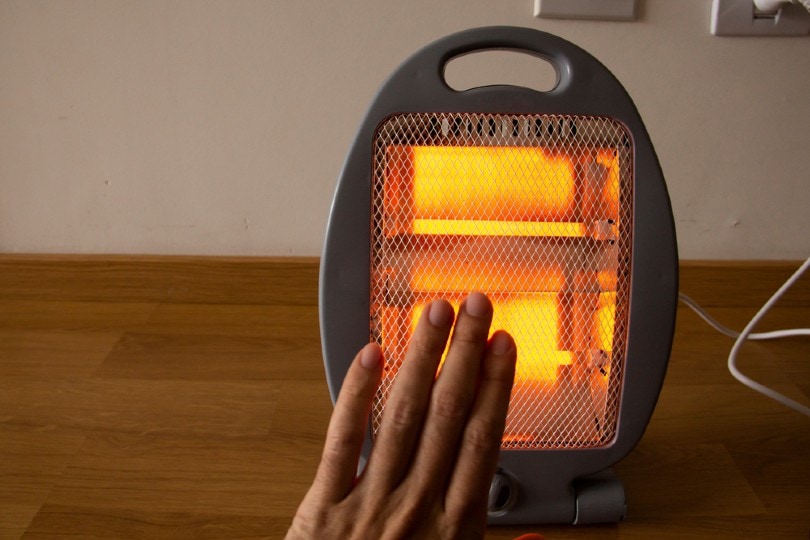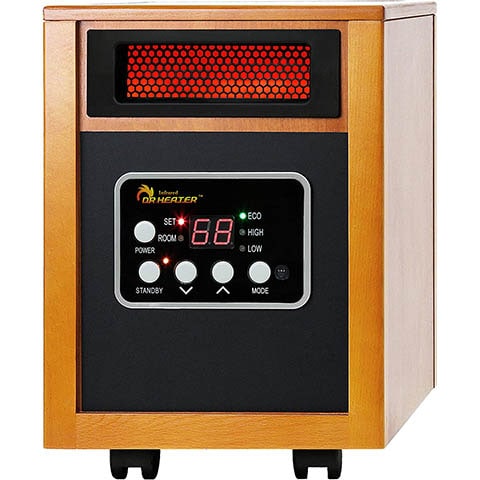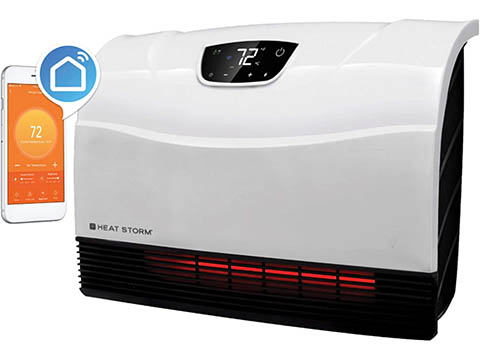10 Best Space Heaters for a Basement in 2025 : Reviews & Top Picks
-

- Last updated:


Cold air is denser than hot air, which means that it sinks while hot air rises. Combined with the cold earth surrounding our basements, this can cause the area to be considerably cooler than the rest of the house. Despite this, few houses have heating systems that reach down into the basement. Whether you regularly use the space as an office, as an occasional games room, or have it as a workspace and utility room, a space heater can help take the chill out of the air.
Below are 10 of the best space heaters for a basement this year, including some for smaller basements and those that are ideal for basements that are the full size of the house. We’ve also included a guide to help you choose the best heater for your space.

A Quick Comparison of Our Favorites in 2025
| Rating | Image | Product | Details | |
|---|---|---|---|---|
Best Overall

|

|
Dr Infrared Portable Space Heater |
|
CHECK PRICE |
Best Value

|

|
GiveBest Portable Space Heater |
|
CHECK PRICE |
Premium Choice

|

|
Duraflame Electric Infrared Fireplace |
|
CHECK PRICE |
|
|

|
Aikoper Space Heater |
|
CHECK PRICE |
|
|

|
Heat Storm WiFi Heater | CHECK PRICE |
The 10 Best Space Heaters for a Basement
1. Dr Infrared Portable Space Heater – Best Overall
| Heater type: | Electric infrared |
| Heater weight: | 19 pounds |
| Maximum power: | 1,500 watts |
The Dr Infrared Heater Portable Space Heater is the best overall space heater for a basement. It has a maximum power of 1,500 watts, so it should provide ample heating for basements of any size.
Its blower and heater are quiet, which means it only produces 39 decibels (dB) of sound, which is lower than most other space heaters, and it has tip-over and overheat protection features to ensure safety even if you are not in the room. A 12-hour automatic shut off timer not only prevents overheating but also saves you electricity if you forget to turn the heater off when you leave the room. Caster wheels make this 19-pound heater easy to move, too, so you can move it in and out of position, as required. It also includes a remote control for easy operation.
Although the Dr Infrared Heater Portable Space Heater is good value for money, falling somewhere in the middle of prices on this list, it is a little bulkier than some other models, so it will not be suitable for confined spaces.
- Quiet heater and fan operation
- The remote control makes it easy to operate from anywhere in the room
- Tip-over and overheat protection
- Caster wheels
- Quite bulky
2. GiveBest Portable Space Heater – Best Value
| Heater type: | Electric ceramic |
| Heater weight: | 2.9 pounds |
| Maximum power: | 1,500 watts |
The GiveBest Portable Electric Space Heater with Thermostat is a good choice for smaller basements, occasional use, or if you need a heater that you can move from room to room with you.
It weighs just under 3 pounds and has a large carry handle, so it is easy to carry, and it has a compact size so should be suitable even in smaller basement spaces. It has tip-over and overheat protection features as well as being made from flame-retardant materials, minimizing the risk of danger. The 45dB noise levels mean it isn’t as quiet as the Dr Infrared, but it is also a fraction of the price, making it the best space heater for a basement for the money. Its thermostat does a good job of maintaining the desired heat or warmth level in your basement.
The major drawback with the GiveBest Portable Electric Space Heater is that it is only capable of heating spaces up to 200 square feet, so if you have a larger basement, it won’t be able to heat the whole area and may come up short.
- Lightweight and portable
- Really inexpensive
- Tip-over and overheat safety functions
- Only heats spaces up to 200 square feet
3. Duraflame Electric Fireplace – Premium Choice
| Heater type: | Electric infrared |
| Heater weight: | 28.6 pounds |
| Maximum power: | 1,500 watts |
The Duraflame DFI-5010-01 Electric Infrared Quartz Fireplace Stove is a fireplace effect space heater that provides up to 5,200 British thermal units (BTU) of heat that the manufacturer claims can heat a space of up to 1,000 square feet. It has an automatic thermostat that is digital and adjustable so you can maintain the desired temperature in your basement without having to guess or keep switching the heater on and off. It is an expensive heater but isn’t meant to be portable—weighing nearly 30 pounds—but it has a nice look.
The heater has a flame effect behind the logs, and you can choose from five colors as well as alter the brightness and the speed of the flames. The heater also comes in a variety of colors and has an overheat safety setting. Although there is no tip-over safety setting, its design and weight means that it is unlikely that the Duraflame will be toppled while in use.
- Heats spaces up to 1,000 square feet
- Flame effect includes multiple settings
- Adjustable, digital thermostat
- Expensive
- No tip-over safety feature
4. Aikoper Space Heater
| Heater type: | Electric ceramic |
| Heater weight: | 6.39 pounds |
| Maximum power: | 1,500 watts |
The Aikoper Space Heater is a ceramic heater with 1,500 watts of power. It has a thermostat, and the desired temperature can be altered in 1°F increments, allowing for precision heating in your basement area. The Aikoper also has an 8-hour timer so you can control when the heater runs and for how long.
The oscillating fan means that it pushes air out of the heater and can cover the whole room rather than just what is in front of the fan. As well as easy-to-use buttons on the tower itself, there is also a remote control, so you don’t have to get out of your chair to change the heater settings. The tip-over and overheat safety functions give peace of mind and protection.
Although the Aikoper is reasonably priced and boasts a good range of settings and control, it doesn’t do as good a job of dispersing heat, so it struggles to heat up larger areas. And, while there is a thermostat, the heater only turns off when it is 4 degrees above or below the target temperature, which means that there is an 8-degree range of temperature, which is more than most.
- Inexpensive ceramic heater
- Tip-over and overheat safety features
- Oscillates to spread warmth
- Only really effective in small areas
- 4-degree thermostat variation
5. Heat Storm Infrared Heater
| Heater type: | Electric infrared wall-mounted |
| Heater weight: | 9 pounds |
| Maximum power: | 1,500 watts |
If you’re looking for a more permanent space heater solution for your basement, the Heat Storm HS-1500-PHX-WiFi Infrared Heater is a good alternative to portable models. It needs to be wall mounted for use and offers a maximum of 1,500 watts of power. Being wall mounted means that it doesn’t take up floor space, and the power cord can be hidden inside the heater, as long as it is mounted above the outlet.
The heater cannot be used on the floor, so it doesn’t have tip-over safety features, and the thermostat will operate within approximately 2°F of the desired temperature. The radiator is relatively lightweight. While this isn’t important for moving it around because it is wall-mounted, it makes it easier to mount and shouldn’t cause any problems on the wall itself. The radiator won’t scorch the wall, either, and it is safe to the touch. It is Wi-Fi compatible and can be operated using a smartphone app. However, the heater is wall mounted, which limits the range it can heat, and the Heat Storm struggles to heat anything other than quite small spaces.
- Wall mounting saves floor space
- Thermostat is reasonably accurate
- Can be controlled by Wi-Fi app
- Struggles with large spaces
- Wall-mounted so not portable and limits range
6. Pelonis Tower Indoor Space Heater
| Heater type: | Electric ceramic |
| Heater weight: | 6 pounds |
| Maximum power: | 1,500 watts |
The Pelonis PHTPU1501 Ceramic Tower Indoor Space Heater is an oscillating electric ceramic heater that has three power settings, an 8-hour timer, and can be operated from the tower itself or using the remote control. It is a relatively lightweight heater, weighing 6 pounds, and its tower design with a carry handle means that it is easy to move around.
Although the heater does oscillate, its 60-degree oscillating angle means that it is quite restricted in terms of distributing heat around a wider area. It is about average-priced for heaters on this list and claims to heat up to a temperature of 70°F in 3 seconds, so it can work to provide you heat quickly when you need it. It also has tip-over and overheat safety features.
As well as a somewhat restrictive rotating angle, the fan is quite loud, putting out 52dB of sound. Also, the thermostat isn’t too accurate.
- Three power modes, including automatic ECO mode
- Tip-over and overheat safety features
- Remote control for easy operation
- Minimal oscillating angle
- 52dB is quite loud compared to others
7. Pelonis Electric Radiator Heater
| Heater type: | Electric oil radiator |
| Heater weight: | 16 pounds |
| Maximum power: | 1,500 watts |
While most of the space heaters above have fans or some other means of pushing warm air out so that it spreads around the room more, the Pelonis Electric 1500W Oil Filled Radiator Heater is a radiant heater. There is no fan so the oil heats up and as the air warms it spreads. The lack of a fan means that the heater is quieter. With just the noise of the oil heating up, it also means that it isn’t as effective at spreading heat around the basement.
The radiator does have three heating options, including an automatic thermostatic mode, and it is well-priced. The Pelonis also has tip-over and overheat safety functions, as well as a 10-hour timer and a clearly visible LCD screen to show the current settings. Although heavier than some of the lightweight fan heaters, it is not too heavy, weighing 16 pounds, and it has castor wheels for easy movement.
- Quiet
- Tip-over and overheat safety features
- LCD screen shows current settings
- Radiant heater doesn’t distribute heat
- Takes some time to warm up to temperature
8. Comfort Zone Ceramic Space Heater
| Heater type: | Electric ceramic |
| Heater weight: | 3.5 pounds |
| Maximum power: | 1,500 watts |
The Comfort Zone CZ448 Oscillating Portable Ceramic Space Heater is a really inexpensive and lightweight electric ceramic heater. It is a fan heater, so it pushes hot air around the room, and the fan is oscillating to help further increase the area and range of the heat. It has analog control knobs on the top of the device with two heat settings, as well as a fan-only setting.
Although it is inexpensive and lightweight, it lacks the automatic thermostat of other devices, has limited controls, and will struggle to heat anything other than a small room. It does have a decent oscillation angle but is quite loud at approximately 55dB of noise right by the unit.
- Good oscillation range
- Really cheap
- Tip-over and overheat safety function
- Louder than most
- Only really suitable for small areas
- Basic functions
9. Lasko Bladeless Heater
| Heater type: | Ceramic blower |
| Heater weight: | 9.4 pounds |
| Maximum power: | 1,500 watts |
The Lasko Bladeless Heater is a ceramic heater that uses blowers to push the warm air out and around the room rather than fans. It is quite a compact unit and weighs under 10 pounds, has high and low settings as well as an automatic thermostat setting, and not only does it lack fans, making it safer, but it also has tip-over and overheat safety functions to provide safe heating.
The fan oscillates a full 360 degrees, which helps distribute warm air well, but it does still struggle to heat more than a small room and may not be powerful enough for a lot of basements. It is quieter than most fan heaters because of its lack of blades, but it has a strong smell that can be difficult to shift. It is also quite pricey for the size of room it can heat.
- Full 360-degree oscillation
- Bladeless design is quiet
- Tip-over and overheat safety features
- Struggles to heat larger areas
- Strong smell
10. Life Smart Black Infrared Heater
| Heater type: | Electric infrared |
| Heater weight: | |
| Maximum power: |
The Life Smart Black 6 Element Infrared Heater is an infrared heater with 1,500 watts of power and that has a full power setting as well as a 1,000-watt setting and an eco setting. The eco setting keeps the temperature at 68°F while optimizing power usage. The manufacturer claims it will heat up to 600 square feet of space and it is made with a stainless-steel casing, which stays cool to the touch.
For the size and feature of the unit, it is a little on the expensive side, and it really struggles to heat large rooms. The fan is also quite loud, and because it doesn’t oscillate and needs to be situated several feet from any items or furniture, it is challenging to get it to heat a reasonable space.
- Eco setting maintains 68°F while optimizing power consumption
- Stainless steel housing is good
- Tip-over and overheat safety features
- A little pricey
- Struggles to heat large spaces
- Fan can be quite loud

Buyer’s Guide: Choosing the Best Space Heaters for a Basement
Not everybody has or wants central heating or other heating systems fitted in the basement, but because cold air sinks and because basements tend to be enveloped in cold soil, it can be the coldest area of the house. Whether the basement is used as a living space or is little more than a storage area that also houses pipes and other essential components of the home, a space heater can help increase its temperature and make it a more hospitable space.
What Is a Space Heater?
A space heater is a single heater that is not connected to a central heating or whole house system. Such heaters can be powered by gas or electricity, although most indoor heaters are electric because it is safer and more energy efficient while also providing uniform heat. There are various different types of space heater available, including wall-mounted and free-standing, as well as a choice of ceramic or infrared heaters.
Ceramic vs. Infrared
There are pros and cons to both ceramic and infrared heaters:
Ceramic Heaters
Ceramic heaters are convection heaters, which means that air is pulled into the heater and passed over a hot ceramic plate before being pushed back into the room via fans or blowers. They tend to be more portable than infrared, and they are energy efficient compared to other heating methods.
Ceramic heaters can be cheaper to buy, too, but they do tend to use fans to disperse heat, which means that they can be loud and they usually work best in enclosed spaces, so you will have to leave doors and windows closed to get the best results from this type of heater.
Infrared Heaters
Infrared heaters are radiant heaters, which means that they use infrared waves to direct heat at surfaces and other objects. These objects will warm up and help heat the room as well. They can also directly warm people in front of the heater. Theoretically, they do not require windows and doors to be kept closed, so you can still ventilate a basement while one is being used, but they are more expensive to buy.
When used over a long period of time, infrared heaters tend to be more energy efficient, too, while the lack of a fan means that they are quieter than their fan-assisted counterparts.
What to Look For
There are a lot of different space heaters available, and while they might all look similar, there are certain important features to consider when buying.
Portability

If your heater is going to stay in the same spot all the time, portability may not be important. But, considering most space heaters perform at their best and are safest when placed several feet away from other items, they need to be in the middle of a room when being used. This means that the heater will probably need to be moved around, so portability will matter in these cases. As well as the weight of the device, you can look for those that have carry handles or that have castor wheels so that they can be easily moved from one spot to another.
Noise Level
Ceramic fan heaters are the most prevalent style of fan heater, and they are among the cheapest options on the market. They do have various advantages, but one of their biggest disadvantages is the noise they make. Fans are not silent, and the constant spinning of the blades can be quite disruptive. If you need a silent fan, either look for a bladeless fan that directs air out of a blower or an infrared heater that doesn’t use fans at all.
Not all manufacturers list the noise level of their fans, but it is especially important if you sleep in the basement or you are looking for a fan to use during meditation, while working, or for anything else that requires concentration and silence.
Safety Features
Whatever type of heater you buy, safety should be at the top of your list of priorities. Heaters are one of the main causes of house fires, and these are usually started when the fan overheats or if it is knocked over so that it comes into contact with the floor. Tip-over shut off means that the heater shuts off if the device is knocked over and will usually come back on when it is put upright again. An overheat safety feature shuts the heater off if it reaches a certain temperature and can prevent fires caused by blockages, malfunctions, or items being placed too close to the heater itself.
Other safety considerations to look for include grills to cover the fan blades and cold-touch housing to prevent fingers and pets getting burned.
Oscillation
Fans and blowers typically project warm air directly forwards, and no matter how well they are designed, they struggle to cover a wide area with heat, instead relying on the air bouncing off surfaces and hot air spreading around a space. Oscillating fans turn, which means that they can push the hot air around a larger space without having to move the fan. If you’re looking for a fan to heat one area of a room, oscillation is not important, but if you want to heat several people or an entire room, an oscillating heater is a good choice.
Is It Safe to Put a Space Heater in the Basement?
Space heaters should be put on the floor, and they usually need to be placed at least a few feet away from objects like furniture and belongings. As long as you follow these guidelines and any manufacturer guidelines, a space heater is just as safe for use in a basement as it is in any room of the house.
Should I Heat a Basement in the Winter?
Space heaters are only really designed to heat one particular room. With that said, hot air does rise, so if you do a good job of heating the entire basement, the warmth will pass upwards and into the rest of the house. In particular, it can give you warm floors on the level above, but don’t rely on a space heater in the basement to heat the whole house.
Why Is My Basement So Cold During Winter?
Basements can be damper than other rooms in the house, and dampness leads to cold temperatures. Furthermore, cold air is denser than warm air, so as cooler air enters your home, it will naturally sink to the basement while any hot air rises to the top of the house.
Do Space Heaters Use a Lot of Electricity?

Space heaters are considered major energy users. Despite being small and manufacturers using terms like 100% efficient, they can add $50 per month to your energy bill if you run one for 8 hours a day. Ensure you only heat the basement when you need to, try to use any economy settings that the heater has, and ensure good insulation and other energy and heat saving features in the basement to reduce the amount of energy you have to use.
Can You Leave a Space Heater on at Night?
Although ceramic and infrared space heaters are considered much safer than electric coil heaters, there are still some risks to using this type of heater, and you should avoid leaving them on overnight. Many modern heaters have timer settings so that you can set them to switch off after several hours. This is a good way to ensure that you have some heat in the evening but that you don’t run the risk of leaving the heater on for 8–10 hours while you can’t monitor the heater.

Conclusion
The best space heaters for a basement include ceramic and infrared heaters, which you will find on our list above. Ensure you choose one with good safety features and according to the size of your basement space, to enjoy the best heating results.
The Dr Infrared Heater Portable Space Heater uses infrared to heat the space. It’s silent and energy efficient, although it is a little more expensive than similarly featured ceramic heaters. If you’re looking for an inexpensive alternative, the GiveBest Portable Electric Space Heater with Thermostat is lightweight enough to be easily portable and is really affordable to buy.
- Related Read: The 8 Best Infrared Space Heaters
Featured Image Credit: New Africa, Shutterstock
Contents










